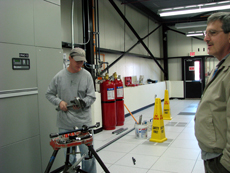GCC extinguishes threat of electronic library fire

Gene Oleynik (right) surveys new fire suppression equipment as Phoenix Fire worker John Sullivan continues installation.
Imagine the devastation a fire would wreak upon a library filled with thousands of volumes. It is easy to picture scorched pages and burnt binding, but even a paperless library could go up in smoke. Gene Oleynik, the head of data storage and caching section at the Grid Computing Center, said that the laboratory takes precautions against such an incident.
In late October, a crew from Phoenix Fire, a company based in Frankfort, IL, installed fire suppression equipment for a new library that will store data from the LHC and Fermilab experiments.
This electronic data storage unit will be the second housed in the GCC tape library room. The new unit, a big, black enclosed box, is empty now, but soon robot-librarians will whisk down the aisles to retrieve data tapes. The current GCC library, which has been running for the past year, receives about 3,000 tape requests per day.
In the unlikely event that a fire does start inside the library, the library, like its predecessors, is equipped with an early warning air sampling device that monitors the air inside for smoke and calls the Fire Department. In addition, smoke alarms sit at both ends of the library. If both alarms go off, two man-sized canisters filled with flame suppressing gas will release their contents into pipes that connect inside the unit. A fire would be suppressed almost instantly, according to Oleynik.
Oleynik said it took about a week for the crew to install the equipment but it is worth it, considering what is at stake. The current library stores up to four petabytes (four million billion bytes) of data, mostly from CMS and CDF. In addition, GCC and FCC libraries store data for DZero, MiniBoone, SDSS, DES, KTeV, SELEX and other projects. All of the experimenters involved in these projects rely upon the libraries for data storage and retrieval. "All of the projects depend upon these facilities," Oleynik said. "We take great care to ensure that the physics data we hold at Fermilab is well protected. GCC systems are protected by the laboratory's fire department systems specialized for data centers, and by this system installed with the tape library."
-- Haley Bridger
|